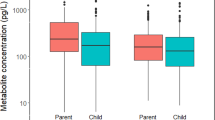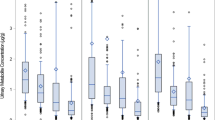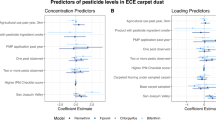Abstract
Young children, because of their immaturity and their rapid development compared to adults, are considered to be more susceptible to the health effects of environmental pollutants. They are also more likely to be exposed to these pollutants, because of their continual exploration of their environments with all their senses. Although there has been increased emphasis in recent years on exposure research aimed at this specific susceptible population, there are still large gaps in the available data, especially in the area of chronic, low-level exposures of children in their home and school environments. A research program on preschool children's exposures was established in 1996 at the USEPA National Exposure Research Laboratory. The emphasis of this program is on children's aggregate exposures to common contaminants in their everyday environments, from multiple media, through all routes of exposure. The current research project, “Children's Total Exposure to Persistent Pesticides and Other Persistent Organic Pollutants,” (CTEPP), is a pilot-scale study of the exposures of 257 children, ages 1½–5 years, and their primary adult caregivers to contaminants in their everyday surroundings. The contaminants of interest include several pesticides, phenols, polychlorinated biphenyls, polycyclic aromatic hydrocarbons, and phthalate esters. Field recruitment and data collection began in February 2000 in North Carolina and were completed in November 2001 in Ohio. This paper describes the design strategy, survey sampling, recruiting, and field methods for the CTEPP study.
This is a preview of subscription content, access via your institution
Access options
Subscribe to this journal
Receive 6 print issues and online access
$259.00 per year
only $43.17 per issue
Buy this article
- Purchase on Springer Link
- Instant access to full article PDF
Prices may be subject to local taxes which are calculated during checkout






Similar content being viewed by others
References
Adgate J.L., Barr D.B., Clayton C.A., Eberly L.E., Freeman N.C., Lioy P.J., Needham L.L., Pellizzari E.D., Quackenboss J.J., Roy A., and Sexton K. Measurement of children's exposure to pesticides: analysis of urinary metabolite levels in a probability-based sample. Environ Health Perspect 2001: 109: 583–590.
Adgate J.L., Clayton C.A., Quackenboss J.J., Thomas K.W., Whitmore R.W., Pellizzari E.D., Lioy P.J., Shubat P., Stroebel C., Freeman N.C.G., and Sexton K. Measurement of multi-pollutant and multi-pathway exposures in a probability-based sample of children: practical strategies for effective field studies. J. Expos Anal Environ Epidemiol 2000: 10: 650–661.
Acheson K.J., Campbell I.T., Edholm O.G., Miller D.S., and Stock M.J. The measurement of food and energy intake in man — an evaluation of some techniques. Am J Clin Nutr 1980: 33: 1147–1154.
Akland G.G., Pellizzari E.D., Hu Y., Roberds M., Rohrer C.A., Leckie J.O., and Berry M.R. Factors influencing total dietary exposures of young children. J Expos Anal Environ Epidemiol 2000: 10: 710–722.
ASTM — Standard practice for collection of floor dust for chemical analysis D5438-94. Annual Book of ASTM Standards. Vol. 11.03. American Society for Testing and Materials, West Conshohoken, PA, 1997, pp. 517–523.
Baker J.A., Mendola P., Barr D., Walsh D., Creason J., and Needham L. Non-residential organophosphorus pesticide use as a predictor of children's urinary metabolite levels. Presented at the Joint Meeting of the International Society of Exposure Analysis and the International Society for Environmental Epidemiology Vancouver, BC, Canada, August, 2002.
Block G. A review of validations of dietary exposure assessment methods. Am J Epidemiol 1982: 115: 492–505.
Brock J.W., Caudill S.P., Silva M.J., Needham L.L., and Hilborn E.D. Phthalate monoesters levels in the urine of young children. Bull Environ Contam in Toxicol 2002: 68: 309–314.
Buckley B., Ettinger A., Hore P., Lioy P., and Freeman N. Using observational information in planning and implementation of field studies with children as subjects. J Expos Anal Environ Epidemiol 2000: 10: 695–702.
Camann D.E., Harding H.J., Geno P.W., and Agrawal S.R. Comparison of Methods to Determine Dislodgeable Residue Transfer from Floors. EPA 600/R-96/089, 1996.
Chuang J.C., Callahan P.J., Lyu C.W., and Wilson N.K. Polycyclic aromatic hydrocarbon exposures of children in low-income families. J Expos Anal Environ Epidemiol 1999a: 9: 85–98.
Chuang J.C., Callahan P.J., Menton R.G., Gordon S.M., Lewis R.G., and Wilson N.K. Monitoring methods for polycyclic aromatic hydrocarbons and their distribution in house dust and track-in soil. Environ Sci Technol 1995: 29: 494–500.
Chuang J.C., Gordon S.M., Roberts J.W., Han W., and Ruby M.G. Evaluation of HVS3 sampler for sampling polycyclic aromatic hydrocarbons and polychlorinated biphenyls. EPA 600/R-94/188, 1994.
Chuang J.C., Hannan S.W., and Wilson N.K. Field comparison of polyurethane foam and XAD2 resin for air sampling for polynuclear aromatic hydrocarbons. Environ Sci Technol 1987: 21: 798–804.
Chuang J.C., Lyu C., Chou Y.L., Callahan P.J., Nishioka M., Andrews K., Pollard M.A., Brackney L., Hines C., Davis D.B., and Menton R. Evaluation and Application of Methods for Estimating Children's Exposure to Persistent Organic Pollutants in Multiple Media. EPA 600/R-98/164a, 164b, and 164c. 1998.
Chuang J.C., Mack G.A., Kuhlman M.R., and Wilson N.K. Polycyclic aromatic hydrocarbons and their derivatives in indoor and outdoor air in an eight-home pilot study. Atmos Environ 1991: 25B: 369–380.
Chuang J.C., Wilson N.K., and Lewis R.G. Methodology of ambient monitoring for polycyclic aromatic hydrocarbons. Fresenius Environ Bull 1999b: 8: 547–556.
Cohen Hubal E.A., Sheldon L.S., McCurdy T.R., Rigas M.L., Burke J.M., and Zartarian V.G. Children's exposure assessment: a review of factors influencing children's exposure, and the data available to characterize and assess that exposure. Environ Health Perspect 2000a: 108(6): 475–486.
Cohen Hubal E.A., Sheldon L.S., Zufall M.J., Burke J.M., and Thomas K.W. The challenge of assessing children's residential exposure to pesticides. J Expos Anal Environ Epidemiol 2000b: 10: 638–649.
Duggan M.J., Inskip M.J., Rudle S.A., and Moorcroft J.S. Lead in playground dust and on the hands of schoolchildren. Sci Total Environ 1985: 44: 65–79.
Federal Register, Vol. 65, No. 33, February 15, 2000, pp. 7555–7557. http://aspe.hhs.gov/poverty/.
Fennema O.R., and Anderson S.A., In: Macdonald I., (Ed.) Monitoring Dietary Intakes. Springer, Berlin, 1991, p. 45.
Fenske R.A., Kedan G., Lu C., Fisker-Andersen J.A., and Curl C.L. Assessment of organophosphate pesticide exposures in the diets of preschool children in Washington State. J Expos Anal Environ Epidemiol 2002a: 12: 21–28.
Fenske R.A., Kissel J.C., Lu C., Kalman D.A., Simcox N.J., Allen E.H., and Keifer M.C. Biologically based pesticide dose estimates for children in an agricultural community. Environ Health Perspect 2000a: 108: 515–520.
Fenske R.A., Lu C., Barr D., and Needham L. Children's exposure to chlorpyrifos and parathion in an agricultural community in central Washington State. Environ Health Perspect 2002b: 110: 549–553.
Fenske R.A., Lu C., Simcox N.J., Loewenherz C., Touchstone J., Moate T.F., Allen E.H., and Kissel J.C. Strategies for assessing children's organophosphorus pesticide exposures in agricultural communities. J Expos Anal Environ Epidemiol 2000b: 10: 662–671.
Fortune C.R. Round-robin Testing of Methods for Collecting Dislodgeable Residues from Carpets. EPA 600/R-97/119, 1997.
FQPA. Food Quality Protection Act of 1996. http://www.epa.gov/opppsps1/fqpa/fqpa-iss.htm.
Freeman N.C., Jimenez M., Reed K.J., Gurunathan S., Edwards R.D., Roy A., Adgate J.L., Pellizzarri E.D., Quackenboss J., Sexton K., and Lioy P.J. Quantitative analysis of children's microactivity patterns: The Minnesota Children's Pesticide Exposure Study. J Expos Anal Environ Epidemiol 2001: 11: 501–509.
Freedman D.M., Stewart P., Kleinerman R.A., Wacholder S., Hatch E.E., Tarone R.E., Robison L.L., and Linet M.S. Household solvent exposures and childhood acute lymphoblastic leukemia. Am J Public Health 2001: 91: 564–567.
Gurunathan S., Robson M., Freeman N., Buckley B., Roy A., Meyer R., Bukowski J., and Lioy P.J. Accumulation of chlorpyrifos on residential surfaces and toys accessible to children. Environ Health Perspect 1998: 106: 9–16.
Heil M., Schilter B., Huggett A.C., and Haschke F. Toxicological aspects of food for infants and children. Monatsschr Kinderheilk 1996: 144 (Suppl. 2): S224–S229.
Heudorf U., and Angerer J. Internal exposure to PAHs of children and adults living in homes with parquet flooring containing high levels of PAHs in the parquet glue. Int J Occup Environ Health 2001: 74: 91–101.
Karmaus W., DeKoning E.P., Kruse H., Witten J., and Osius N. Early childhood determinants of organochlorine concentrations in school-aged children. Pediatr Res 2001: 50: 322–323.
Koch D., Lu C., Fisker-Andersen J., Jolley L., and Fenske R.A. Temporal association of children's pesticide exposure and agricultural spraying: Report of a longitudinal biological monitoring study. Environ Health Perspect 2002: 110: 829–833.
Landrigan P.J. Pesticides and polychlorinated biphenyls (PCBs): an analysis of the evidence that they impair children's neurobehavioral development. Mol Genet Metab 2001: 73: 11–17.
Landrigan P.J., Claudio L., Markowitz S.B., Berkowitz G.S., Brenner B.L., Romero H., Wetmer J.G., Matte T.D., Gore A.C., Godbold J.H., and Wolff M.S. Pesticides and inner-city children: exposures, risks, and prevention. Environ Health Perspect 1999: 107(Suppl. 3): 431–437.
Lewis R.G., Fortmann R.C., and Camann D.E. Evaluation of methods for monitoring the potential exposure of small children to pesticides in the residential environment. Arch Environ Contamin Toxicol 1994: 26: 37–46.
Lu C., Knutson D.E., Fisker-Andersen J., and Fenske R.A. Biological monitoring survey of organophosphorus pesticide exposures among pre-school children in the Seattle metropolitan area. Environ Health Perspect 2001: 109: 299–303.
Lyu C., Wilson N.K., Chuang J.C., Satola J., and Morgan M.K. Recruitment and field sampling in the CTEPP North Carolina and Ohio field studies. Presented in the Symposium on Young Children's Exposures to Persistent Organic Pollutants at the joint meeting of the International Society of Exposure Analysis and the International Society for Environmental Epidemiology, Vancouver, BC, Canada, August, 2002.
Mills P.K., and Zahm S.H. Organophosphate pesticide residues in urine of farmworkers and their children in Fresno County, California. Am J Ind Med 2001: 40: 571–577.
Mukerjee D. Assessment of risk from multimedia exposures of children to environmental chemicals. J Air Waste Manag Assoc 1998: 48: 483–501.
Needham L.L., and Sexton K. Assessing children's exposure to hazardous environmental chemicals: an overview of selected research challenges and complexities. J Expos Anal Environ Epidemiol 2000: 10: 611–629.
Nishioka M.G., Lewis R.G., Brinkman M.C., Burkholder H.M., Hines C.E., and Menkedick J.R. Distribution of 2,4-D in air and on surfaces inside residences after lawn applications: comparing exposure estimates from various media for young children. Environ Health Perspect 2001: 109: 1185–1191.
O'Rourke M.K., Lizardi P.S., Rogan S.P., Freeman N.C., Aguirre A., and Saint C.G. Pesticide exposure and creatinine variation among young children. J Expos Anal Environ Epidemiol 2000: 10: 672–681.
Perera F.P., Illman S.M., Kinney P.L., Whyatt R.M., Kelvin E.A., Shepard P., Evans D., Fullilove M., Ford J., Miller R.L., Meyer I.H., and Rauh V.A. The challenge of preventing environmentally related disease in young children: community-based research in New York City. Environ Health Perspect 2002: 110: 197–204.
Raymer J.H., Akland G., Hu Y., Spruill M., Briggs K., and Childs B. Study of exposure and body burden of children of different ages to pesticides in the environment. Presented in the Symposium on Young Children's Exposures to Persistent Organic Pollutants at the Joint Meeting of the International Society of Exposure Analysis and the International Society for Environmental Epidemiology, Vancouver, BC, Canada, August, 2002.
Rigas M.L., Okino M.S., and Quackenboss J.J. Use of a pharmacokinetic model to assess chlorpyrifos exposure and dose in children, based on urinary biomarker measurements. Toxicol Sci 2001: 61: 374–381.
Stanek III E.J., and Calabrese E.J. Daily estimates of soil ingestion in children. Environ Health Perspect 1995: 103: 276–285.
Tulve N.S., Suggs J.C., McCurdy T., Cohen Hubal E.A., and Moya J. Frequency of mouthing behavior in young children. J Expos Anal Environ Epidemiol 2002a: 12: 259–264.
Tulve N.S., Whitaker D., Fortmann R., Brown H., Bozeman E.R., Hilliard A., and Naeher L.P. Environmental measurements of organophosphate and pyrethroid pesticides to assess exposures of young children living in Jacksonville, FL. Presented in the Symposium on Young Children's Exposures to Persistent Organic Pollutants at the Joint Meeting of the International Society of Exposure Analysis and the International Society for Environmental Epidemiology, Vancouver, BC, Canada, August, 2002b.
US Census Bureau. Current Population Survey 1960–2002. Annual Demographic Supplements, and Census 2000 Summary File, 2002. http://factfinder.census.gov/.
Vonmanikowsky S., Sagunski H., Papke O., Fabig K.R., Neus H., Schumann F., Spannhake I., Karmaus W., Osius N., and Zier B. PCDD/PCDF indoor exposure in day-care centers and PCDD/PCDF blood concentrations of female employees. Environ Health Perspect 1998: 106(Suppl. 2): 707–714.
WIC (Women, Infants, and Children). 2000. http://www.fns.usda.gov/wic/.
Wilhelm M., Schrey P., Wittsiepe J., and Heinzow B. Dietary intake of persistent organic pollutants (POPs) by German children using duplicate portion sampling. Int J Hyg Environ Health 2002: 204: 359–362.
Wilson N.K., Chuang J.C., and Kuhlman M.R. Sampling polycyclic aromatic hydrocarbons and related semivolatile organic compounds in indoor air. Indoor Air 1991: 4: 513–521.
Wilson N.K., Chuang J.C., and Lyu C. Evaluation of field methods for estimating exposure of children in low-income families to polycyclic aromatic hydrocarbons. Measurement of Toxic and Related Air Pollutants. VIP-64: Air and Waste Management Association, Pittsburgh, PA,, 1996: (VIP-64): 797–802.
Wilson N.K., Chuang J.C., and Lyu C. Multimedia concentrations of PAH in several day care centers. Polycyclic Aromatic Compds 1999: 17: 255–265.
Wilson N.K., Chuang J.C., and Lyu C. PAH exposures of nine preschool children. Polycyclic Aromatic Compds 2000: 21: 247–259.
Wilson N.K., Chuang J.C., and Lyu C. Levels of persistent organic pollutants in several child day care centers. J Expos Anal Environ Epidemiol 2001: 11: 449–458.
Wilson N.K., Chuang J.C., Lyu C., Menton R., and Morgan M.K. Aggregate exposures of nine preschool children to persistent organic pollutants at day care and at home. J Expos Anal Environ Epidemiol 2003: 13: 187–202.
Acknowledgements
Many persons contributed to the design and field activities of CTEPP, including the individuals mentioned specifically below. For their contributions to the recruitment and field activities, we thank Suzanne Anderson, Carey Aselage, Suzanne Benny, Chad Book, Tori Branch, Brigette Brevard, Lisa Bryant, Martha Chapman, John Cashwell, Fred Crane, Carla Dagnino, Lauren DiBiase, Josh Finegold, Stephanie Gray, LaTisha Griffin, Sherry Hubbard, Robyn Imm, Leslie Lantz, Donna Magbag, Greg McDevitt, James McDonell, Frances Patterson, Jan Satola, Eiko Weller, Leslie Wilson, and Susan Winnard. For their insightful suggestions on the design of the study, we thank Gary Evans, Robert Lewis, Thomas McCurdy, Elaine Cohen Hubal, Maurice Berry, Jim Quackenboss, Elizabeth Betz, and Carvin Stevens. For their valuable comments on the study design, we thank Maria Morandi, Ross Leidy, and Natalie Freeman. Additionally, we thank Robert Lordo for his helpful review and comments on survey sampling.
The United States Environmental Protection Agency through its Office of Research and Development funded and managed the research described here under Contract #68–D99–011 to Battelle. It has been subjected to Agency review and approved for publication. Mention of trade names or commercial products does not constitute an endorsement or recommendation for use.
Author information
Authors and Affiliations
Corresponding author
Rights and permissions
About this article
Cite this article
Wilson, N., Chuang, J., Iachan, R. et al. Design and sampling methodology for a large study of preschool children's aggregate exposures to persistent organic pollutants in their everyday environments. J Expo Sci Environ Epidemiol 14, 260–274 (2004). https://doi.org/10.1038/sj.jea.7500326
Received:
Accepted:
Published:
Issue Date:
DOI: https://doi.org/10.1038/sj.jea.7500326
Keywords
This article is cited by
-
Quantifying children's aggregate (dietary and residential) exposure and dose to permethrin: application and evaluation of EPA's probabilistic SHEDS-Multimedia model
Journal of Exposure Science & Environmental Epidemiology (2012)
-
The reliability of using urinary biomarkers to estimate children's exposures to chlorpyrifos and diazinon
Journal of Exposure Science & Environmental Epidemiology (2011)
-
Exposures of preschool children to chlorpyrifos, diazinon, pentachlorophenol, and 2,4-dichlorophenoxyacetic acid over 3 years from 2003 to 2005: A longitudinal model
Journal of Exposure Science & Environmental Epidemiology (2010)
-
Current and Historically Used Pesticides in Residential Soil from 11 Homes in Atlanta, Georgia, USA
Archives of Environmental Contamination and Toxicology (2010)
-
Reconstructing population exposures to environmental chemicals from biomarkers: Challenges and opportunities
Journal of Exposure Science & Environmental Epidemiology (2009)



